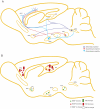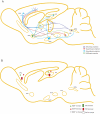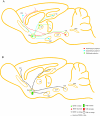Brain-derived neurotrophic factor and neuropsychiatric disorders
- PMID: 22407616
- PMCID: PMC3310485
- DOI: 10.1124/pr.111.005108
Brain-derived neurotrophic factor and neuropsychiatric disorders
Abstract
Brain derived neurotrophic factor (BDNF) is the most prevalent growth factor in the central nervous system (CNS). It is essential for the development of the CNS and for neuronal plasticity. Because BDNF plays a crucial role in development and plasticity of the brain, it is widely implicated in psychiatric diseases. This review provides a summary of clinical and preclinical evidence for the involvement of this ubiquitous growth factor in major depressive disorder, schizophrenia, addiction, Rett syndrome, as well as other psychiatric and neurodevelopmental diseases. In addition, the review includes a discussion of the role of BDNF in the mechanism of action of pharmacological therapies currently used to treat these diseases, such antidepressants and antipsychotics. The review also covers a critique of experimental therapies such as BDNF mimetics and discusses the value of BDNF as a target for future drug development.
Figures




References
-
- Advani T, Koek W, Hensler JG. (2009) Gender differences in the enhanced vulnerability of BDNF+/- mice to mild stress. Int J Neuropsychopharmacol 12:583–588 - PubMed
Publication types
MeSH terms
Substances
Grants and funding
LinkOut - more resources
Full Text Sources
Other Literature Sources
Medical

